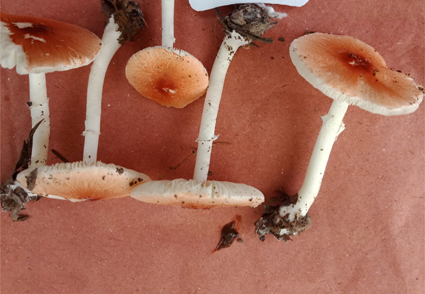Abstract
During a study of the genus Leucoagaricus in Pakistan, we collected a putatively new species with a distinct morphology, anatomy and ITS nrDNA profile from Changa Manga, Punjab. The new species is characterized by the presence of reddish brown central squamules on a milk-white background, thick-walled and ellipsoid spores, narrowly sub-cylindrical to subclavate cheilocystidia and cylindrical stipe. A full description, color photographs, line drawings and a phylogenetic tree of the new species are provided.
References
- Ahmad, S., Iqbal, S.H. & Khalid, A.N. (1997) Fungi of Pakistan. Mycological Society of Pakistan. University of the Punjab.
- Ashraf, S., Naseer, A., Usman, M. & Khalid, A.N. (2023) Two new species of genus Leucoagaricus (Agaricaceae, Agaricales) from Pakistan. MycoKeys 96: 159–171. https://doi.org/10.3897/mycokeys.96.101745
- Bon, M. (1990) Flore mycologique d’Europe. Association d’Ecologie et de Mycologie.
- Color, M. (1975) Munsell soil colour charts. Munsell Color Company: Baltimore, MD.
- Doyle, J.J. & Doyle, J.L. (1987) A rapid DNA isolation procedure for small quantities of fresh leaf tissue. Phytochemical Bulletin 19 (1): 11–15.
- Gardes, M. & Bruns, T.D. (1993) ITS primers with enhanced specificity for basidiomycetes‐application to the identification of mycorrhizae and rusts. Molecular ecology 2 (2): 113–118. https://doi.org/10.1111/j.1365-294X.1993.tb00005.x
- Ge, Z.W., Yang, Z.L., Qasim, T., Nawaz, R., Khalid, A.N. & Vellinga, E.C. (2015) Four new species in Leucoagaricus (Agaricaceae, basidiomycota) from Asia. Mycologia 107 (5): 1033–1044. https://doi.org/10.3852/14-351
- Hall, T. (1999) BioEdit: a user-friendly biological sequence alignment editor and analysis program for Windows 95/98/NT. Nucleic Acids Symposium Series 41: 95–98.
- He, M.Q., Zhao, R.L., Hyde, K.D., Begerow, D., Kemler, M., Yurkov, A., McKenzie, E.H.C., Raspé, O., Kakishima, M., Sánchez-Ramírez, S., Vellinga, E.C., Halling, R., Papp, V., Zmitrovich, I.V., Buyck, B., Ertz, D., Wijayawardene, N.N., Cui, B.K., Schoutteten, N., Liu, X.Z., Li, T.H., Yao, Y.J., Zhu, X.Y., Liu, A.Q., Li, G.J., Zhang, M.Z., Ling, Z.L., Cao, B., Antonín, V., Boekhout, T., Da Silva, B.D.B., De Crop, E., Decock, C., Dima, B., Dutta, A.K., Fell, J.W., Geml, J., Ghobad-Nejhad, M., Giachini, A.J., Gibertoni, T.B., Gorjón, S.P., Haelewaters, D., He, S.H., Hodkinson, B.P., Horak, E., Hoshino, T., Justo, A., Lim, Y.W., Menolli Jr, N., Mešić, A., Moncalvo, J.M., Mueller, G.M., Nagy, L.G., Nilsson, R.H., Noordeloos, M., Nuytinck, J., Orihara, T., Ratchadawan, C., Rajchenberg, M., SilvaFilho, A.G.S., Sulzbacher, M.A., Tkalčec, Z., Valenzuela, R., Verbeken, A., Vizzini, A., Wartchow, F., Wei, T.Z., Weiß, M., Zhao, C.L. & Kirk, P.M. (2019) Notes, outline and divergence times of Basidiomycota. Fungal diversity 99 (1): 105–367. https://doi.org/10.1007/s13225-019-00435-4
- Jabeen, S., Waseem, B., Hamid, M. & Yasmeen, A. (2020) First record of Leucoagaricus nivalis from Pakistan. Bangladesh Journal of Plant Taxonomy 27 (2): 453. https://doi.org/10.3329/bjpt.v27i2.50684
- Johnson, J. (1999) Phylogenetic relationships within Lepiota sensu lato based on morphological and molecular data. Mycologia 91 (3): 443–458. https://doi.org/10.1080/00275514.1999.12061038
- Johnson, J. & Vilgalys, R. (1998) Phylogenetic systematics of Lepiota sensu lato based on nuclear large subunit rDNA evidence. Mycologia 90 (6): 971–979. https://doi.org/10.1080/00275514.1998.12026994
- Katoh, K. & Toh, H. (2008) Recent developments in the MAFFT multiple sequence alignment program. Brief Bioinform 9: 286–298. https://doi.org/10.1093/bib/bbn013
- Liang, J.F. & Yang, Z.L. (2011) A new species of Lepiota (Agaricaceae) from southwestern China. Mycotaxon 117 (1): 359–363. https://doi.org/10.5248/117.359
- Liu, L., Scolnick, D.M., Trievel, R.C., Zhang, H.B., Marmorstein, R., Halazonetis, T.D. & Berger, S.L. (1999) P53 sites acetylated in vitro by PCAF and p300 are acetylated in vivo in response to DNA damage. Molecular and cellular biology 19 (2): 1202–1209. https://doi.org/10.1128/MCB.19.2.1202
- Ma, Yunrui, Tiezhi Liu, Xiaodan Yu, Tiezheng Wei, and Zai-Wei Ge. (2022) Six New Species of Leucoagaricus (Agaricaceae) from Northeastern China. Diversity 14 (5): 314. https://doi.org/10.3390/d14050314
- Miller, M.A., Pfeiffer, W. & Schwartz, T. (2010 [November]) Creating the CIPRES Science Gateway for inference of large phylogenetic trees. In: 2010 gateway computing environments workshop (GCE). Ieee. pp. 1–8. https://doi.org/10.1109/GCE.2010.5676129
- Niazi, A.R., Afshan, N.S. & Razzaq, A. (2015) Fungal diversity in World largest Man-made forest, Changa Manga, Pakistan. Published in proceeding of International Conference on Chemical, Agricultural and Biological sciences organized by Emirates association of Chemical, Biological and Environmental Engineers, Istanbul, Turkey, pp. 174–179.
- Posada, D. (2008) jModelTest: phylogenetic model averaging. Molecular biology and evolution 25 (7): 1253–1256. https://doi.org/10.1093/molbev/msn083
- Qasim, T., Amir, T., Nawaz, R., Niazi, A.R. & Khalid, A.N. (2015) Leucoagaricus lahorensis, a new species of L. sect. Rubrotincti. Mycotaxon 130 (2): 533–541. https://doi.org/10.5248/130.533
- Qasim, T., Khalid, A. & Vellinga, E. (2016) A new species of Lepiota, Lepiota lahorensis, from Lahore, Pakistan. Turkish Journal of Botany 40 (4): 419–426. https://doi.org/10.3906/bot-1507-31
- Rambaut, A. (2014) FigTree 1.4. 2 software. Institute of Evolutionary Biology, Univ. Edinburgh.
- Singer, R. (1948) Diagnoses fungorum novorum Agaricalium. Sydowia 2: 26–42.
- Singer, R. (1975) The Agaricales in Modern Taxonomy (3rd eds.) Cramer, Vaduz.
- Singer, R. (1986) The Agaricales in modern taxonomy 4 (981): 82.
- Stamatakis, A. (2014) RAxML version 8: a tool for phylogenetic analysis and post-analysis of large phylogenies. Bioinformatics 30 (9): 1312–1313. https://doi.org/10.1093/bioinformatics/btu033
- Vellinga, E.C. (2001) Macrolepiota. In: Noordeloos, M.E., Kuyper, T.W. & Vellinga, E.C. (Eds.) Flora agaricina neerlandica. Lisse, Abingdon, Exton (PA).
- Vellinga, E.C. (2004) Ecology and distribution of lepiotaceous fungi (Agaricaceae)—A review. Nova Hedwigia 78 (3): 273–300. https://doi.org/10.1127/0029-5035/2004/0078-0273


